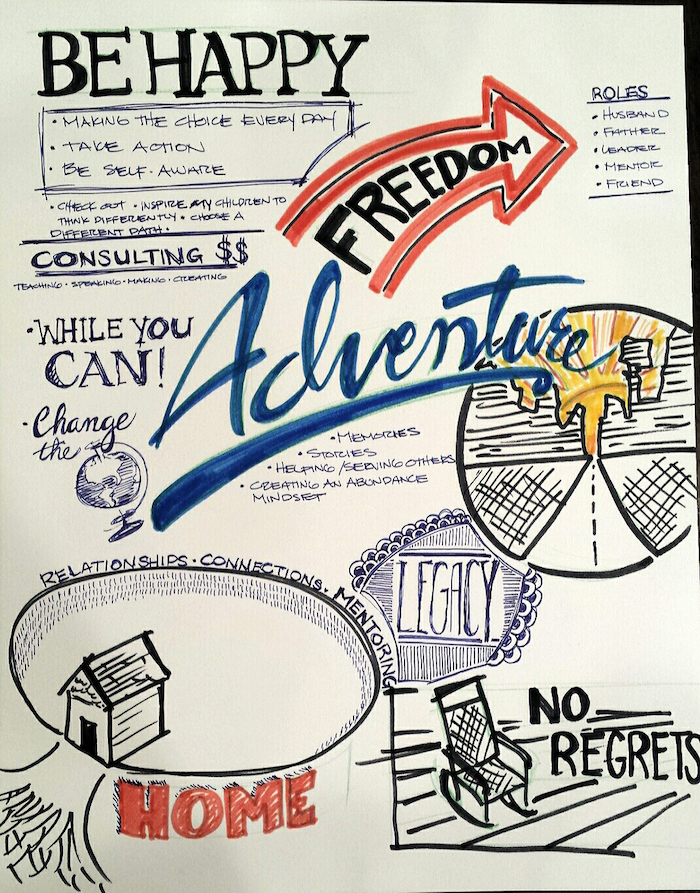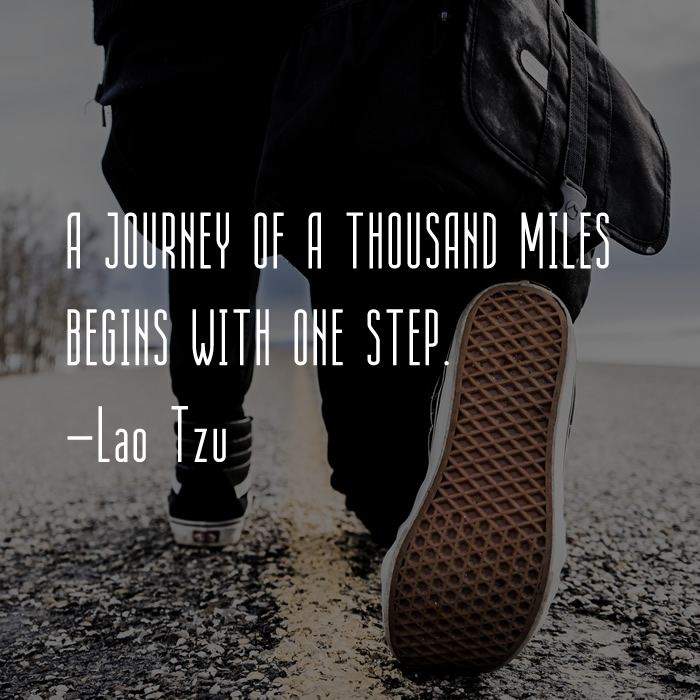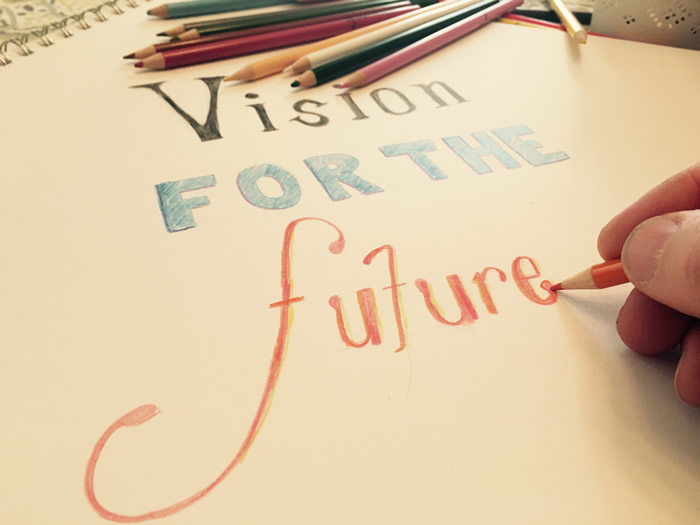I’m worthless without vision. I cannot plan, act, do—in fact, I can’t even take the first step—without a vision. Just ask my wife about our current home renovation. 🙂
To me, vision is a dream painted out on the mind’s canvas. I’ve spent time being a dreamer, and I’ve spent time doing without a plan, and I’ve measured the results of both. If a dream is a destination, vision is the map and compass to get there. A dream can pop into your head, but vision takes work to flesh out the detail. So, how do you articulate your vision in a format that’s life-altering?
Vision Board—the work behind visioning
Early in 2009, I was asked to participate in a “vision board exercise.†“Whoa!†I thought, “What have I gotten myself into? This is going to involve peyote, sweat shops, and visions.†It was nothing of the sort. A few of us met in a room talked about our future, talked about the present, and somehow resolved to move our lives in the direction of our futures. No guitars were strumming Kumbayah, no trust falls, just a few folks having honest conversations about their lives and dreams.
As it turns out, the vision board exercise directed our paths. For me, I gained a different perspective with less anxiety about my current circumstances and focused on changing some of the things that prevented me from moving the direction I articulated in my vision board. Most importantly, I subconsciously began making more intuitive decisions that aligned with my newly articulated vision.
Systematically, the obstacles standing in the way of my vision eventually went away, and I found the vision to become reality. This, of course, was not a coincidence. I am not alone. The other participants in that vision board also changed their course to see their visions become reality. I’m a believer.
Here is a vision board that Shawn Van Dyke created at our February meeting:

Guiding a vision board exercise
Over the course of the last few years, I’ve told friends about the vision board. They too were likely conjuring up the peyote vision quest images in their mind, which the very thought of me in a loin cloth will induce night terrors; however, they pacified me with, “I might be interested in participating.†Well, it must have worked. In February, 5 friends joined me at a sweat lodge my conference room, and I facilitated some exercises I had put together to begin the quest into the vision. We scheduled 4 hours—we went 6; we planned for breaks—we took none; and I planned for a blasé response—but everyone engaged with honesty and vulnerability. They took the first step to making the dream a reality.

Why vision boards work
We can write out goals, create “resolutions,†and plan bits and pieces, but without the unifying clarity of vision, we symptomatically treat the future. After making a career out of selling air and making dreams a reality, I can tell you riffing on the future is a funny business. Creatives especially are in the business of starting with an idea and then bringing that idea to life. I’ve had lots of mishaps in this department with some very talented teams because it’s hard to share a loose collection of ideas. Everyone must share a common vision of what they are doing and how they are contributing.
Where there is no vision, the people perish – Proverbs 29:18
Leaders plant vision. By definition, at least one person follows a leader. Great leaders paint a picture of the future, unify people around that vision, and ultimately cause them to act. Think about Martin Luther King Jr.’s I have a Dream speech. It powerfully paints a vivid picture of his vision:
Now imagine if instead he said, “I want everyone to form peaceful protests and even die to help end discrimination.†It just doesn’t have the same ring. The vision of a color-blind world certainly had tactics, but the tactics supported making the vision a reality. Most importantly, the words of “all men being equal†are planted deep into the psyche of the followers. If you have not read the speech in a while, I strongly encourage you to take a few minutes to watch or read the speech.
5 key reasons that vision boards work
- Programs the subconscious – Programming the subconscious is perhaps the greatest advantage of visioning. Under Kahneman’s analysis of our mental processing, the act of thoroughly envisioning the future is a System II exercise. It is the analytical process of looking into the future and saying “this is what I DO want, and this is what I DON’T WANTâ€, and finally “THIS IS WHAT STANDS IN MY WAY.†Once that heavy lifting is complete, the System I system of thought becomes a silent sidekick in the decision process. Said differently, the act of visioning helps to program the subconscious.
- Clarifies vision and creates a decision Framework – We make decisions based on a series of calculations. We typically, in an instant, can evaluate a decision. Is this consistent with my values? How does this affect those around me? Is this good for me? etc. But, when it comes to whether a decision helps accomplish a set of goals, the decision becomes harder. It is easy for our analytical minds to balance the decisions. A clear vision provides a framework to make the decision process easier.
- Creates Peace and Focus – Have you ever said, “I feel wayward†or “I feel like a kite drifting in the air?†Without vision, you may find yourself meandering through life without guardrails informing your direction. Unfortunately, the waywardness is very unsettling—like standing on shifting ground. Vision focuses your movement through life and grounds you. You can regularly evaluate whether you are moving in the direction of your destination. Also, most importantly vision creates stasis and peace. When I step out of my vision, the peace is disrupted.
- Reflecting changes your attitude – Before I completed the vision board, I was not much of a “meditator.†Seeing the vision gave me a reason to reflect on the obstacles and the destination. Along the journey, I began to spend time thinking about what was working, what wasn’t, and most importantly, what I was thankful for. This reflection had a side-benefit of calming my mind and spirit and being more thoughtful and resolved in action.
- Creates accountability by verbalizing – It’s not real until you tell someone. The first time is tough. What if they laugh? Once you have a clear picture of your vision, it is easy to tell someone, with great detail, what you are doing with your life. As you are speaking, you test whether it is articulating your vision. Also, verbalizing seems to transform reality. I won’t get all mystical here, but I will say that there is power in speaking your vision. When I was 18, I began telling friends that I was going to buy a house and renovate it before I had any notion of where, what, or how this would happen. 30 days after my 19th birthday, I bought a historic home and began renovations on a house that served as rental property through college. I attribute a big part of that to verbalizing the vision to friends.
A trial run
Here is a quick thought exercise that walks through a similar process. It is a poor substitute for being in person, but it may give you a taste of the process. Take 15 minutes to get into a quiet place, calm your mind, and go through these steps:
- Imagine the most difficult problem you are facing.
- Calm your mind and make an honest self-assessment of what would satisfy you as a resolution.
- How does it look?
- What feels right?
- What pieces have to fall into place?
- Write down the words that come to mind if it were resolved.
- Now, why not? What is standing in the way of this state being the reality today? Write the words or narrative that is preventing this from being a reality today.
- Focus on the perfect state every morning and the peace of that place.
- For 2 minutes every day, calm your mind and consider whether the obstacles are moving, and you are overcoming the problem.
If you have success, please share in the comments, or drop me a line.
Conclusion
Vision is critical to living a reflective, satisfying life. I was in my mid-thirties before I went through the exercise. At the time, I was in a highly chaotic, powerless situation with my job and many aspects of home life. In the course of pursuing my vision, I changed jobs, moved into a different home, changed the way I parented, became more present to my family, lost weight, and ultimately improved my mental and spiritual health. There is no get-rich-quick scheme. It takes work, time, and reflection, but I believe taking the time to dream and vision your future pays a rich dividend.
If this interests you and might like to participate in a session, message me. I would like to facilitate a vision board session once a quarter. Going through this process with others recharges my batteries. I cannot guarantee a slot because the group cannot get much larger than 5–6, but we can discuss based on demand.
If you want to learn more, here are some links for your review.
List and Links to Resources
Podcasts
- EOFIRE – John Lee Dumas
- Dose of Leadership – Richard Rierson
Books:
- The Complete Vision Board Kit, John Assaraf
- The Power of Starting Something Stupid – Richie Norton
- Creativity Inc – Ed Catmull (Pixar CEO)
- The War of Art – Steven Pressfield
- The Happiness Advantage – Shawn Achor
- The Seasons of Life – Jim Rohn
- Start with Why – Simon Sinek’s Stuff
- Beyond Halftime – Bob Buford
- Man’s Search for Meaning – Viktor Frankl
